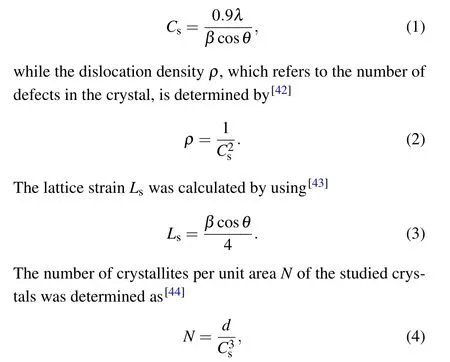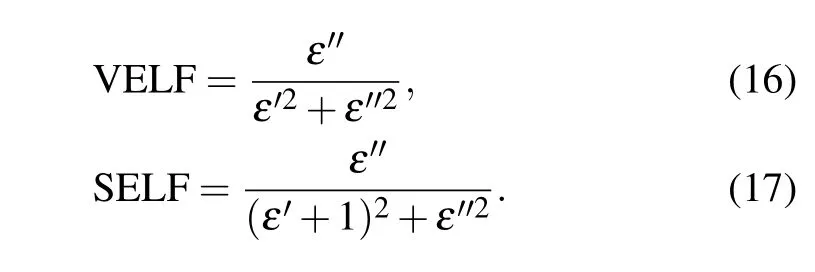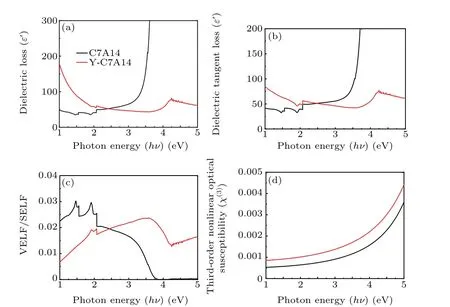Synthesis and study the influence of yttrium doping on band structure,optical,non-linear optical and dielectric results for Ca12Al14O33(C12A7)single crystals grown using traveling-solvent floating zone(TSFZ)method
2022-01-23AbdelMoezAhmedAliandTayel
A.Abdel Moez Ahmed I.Ali and A.Tayel
1Solid State Physics Department,Physical Research Division,National Research Centre(NRC),33 El Bohouth Street,Dokki,Giza 12622,Egypt
2Basic Science Department,Faculty of Faculty of Technology and Education,Helwan University,Kobry El-Qopa,Cairo 11281,Egypt
Keywords: syntheses Ca12Al14O33 (C12A7) single crystals, Y-doping, optical parameters, dielectric results,nonlinear optical susceptibility
1. Introduction
Because of their importance in electronics applications and their common use in modern technology,[1,2]calcium aluminates have been widely and successfully used for the construction[3]of luminescent materials.[4-6]Calcium aluminates glasses have attracted attention of the scientists because of their unique properties,[7]such as optical and mechanical properties.[8,9]Due to their properties, these materials are widely used in many electronics and bone applications.[10,11]There are many methods for preparing Ca12Al14O33crystals (C12A7) including the solvent floating zone method(SFZM)[12]that gives high quality single crystals, selfpropagating combustion method,solid state reaction,[13]citric acid and the sol-gel combustion method.[14]More CaAl4O7single crystals were synthesized by the citric acid precursor method.[15]The crystal structure of Ca12Al14O33(C12A7) is cubic (ao= 11.982 ˚A,[16]and C12A7 is known as an oxygen ionic conductor).[17]Many authors found that C12A7 has only one crystal structure, which has four positive charges with O2anions.[18-20]C12A7 crystals have body-centered cubic structure.[21,22]Moreover, the defect structure of C12A7 was studied[23-25]to describe the chemical defects.
The physical properties of C12A7 have been studied widely such as the electric properties,[26]thermodynamic[27]and optical properties.[28]The influence of doping of Er-ion on both of structure and Raman absorption spectra for 12Ca7Al powders have been studied,[29]and it was noticed that,the optical properties depend on the phase transformation of the Ca-Al-O system.[30]The effect of Eu-dopant on the blue emission of 12CaO·7Al2O3thin films was reported[31]that Eu films exhibit blue emission peak at 444 nm, while it was found that CaAl2O4doped with Er3+exhibits emission band at 523 nm and 547 nm,[32]and also Eu2+ion affects on the absorption spectra for Ca12Al10·6Si3·4O32Cl5.4.[33]Moreover,Eu effects the optical emission spectra for CaAl2O4samples.[34]The effect of temperature on the physical properties of CaAl4O7doped with Eu3+was studied[35,36]and found the sample with photoluminescence spectrum from 340 nm to 420 nm[35]also had emitted green and red up-conversion emissions.[36]While the effect of doping with Nd3+/Yb3+in co-doped Ca12Al14O3on both of down conversion(DC)and up conversion(UC)processes have been investigated,[37]and the influence of doped with Mn+4ion on the luminescent properties of CaAl4O7powder[38,39]and fluorescence properties[40]was studied.
In this paper,single crystals of Ca12Al14O33(C12A7)and Y0.02Ca11.98Al14O33(Y-C12A7) have been generated by using the traveling-solvent floating zone method (TSFZ). XRD is used to characterize the single crystals. Optical measurements such as transmission (T) and reflection (R) have been carried out for C12A7 and Y-doped C12A7 single crystals to calculate the optical parameters such as optical energy gap,n,Eo,Ed,VELF,and SELF.Moreover,the third-order nonlinear optical susceptibility(χ(3))has been estimated.
2. Experimental work
2.1. Ingot material preparation
C12A7 polycrystalline samples were carefully fabricated to avoid extrinsic (impurity) effects by using high-purity chemicals CaCO3(99.995% Aldrich) and Al2O3(99.99%Aldrich). Powders of CaCO3, Al2O3and Y2O3were mixed for preparations of stoichiometric Ca12Al14O33(C12A7) and Y0.02Ca11.98Al14O33(Y-C12A7) polycrystalline. The mixed powder was ground well and heated up to 1100°C with oxygen flow for 24 hours. The powders was ground again and put into a rubber tubes,then pressed under a hydrostatic pressure of 300 MPa to form a rod shape. The pressed rods were sintered at 1250°C in oxygen flow for 12 hours.
2.2. The traveling floating zone melting technique
The sintered polycrystalline rods were used as feed and seed for single crystals. The conditions of the typical growth run were as follows: The growth rate was 0.3 mm/h-0.4 mm/h,and the polycrystalline rod and growing crystal rod were rotated at 25 rpm and 20 rpm in direction opposite to each other, respectively. It was also found that the bubbles and cracks were decreased with high temperature for the crystal. The surfaces for these single crystals were investigated to avoid the effects of grain boundaries and surfaces. The polycrystalline and single-crystal samples were heated at 1300°C for 2 h in presence of mixing gas of 20%H2/80%N2,and finally these crystals were rapidly cooled to room temperature.The crystal structure analysis was carried out by using x-ray diffraction of type(XRD;Rigaku,D/MAXRc)with CuKαradiation at a wavelength of 1.54 ˚A.The optical measurements such as transmission and reflection spectra of the single crystals samples were measured by using UV/VIS double-beam spectrophotometer of type(Cary 5E).
3. Results and discussion
3.1. Structure
XRD results of C12A7 and Y-C12A7 single crystals are shown in Fig.1. It was found that the doping affected on both the peaks intensity and a full width at half maximum(FWHM)of these studied samples.
The crystallite sizeCsof these crystals has been calculated as[41]

wheredis the crystal thickness. The calculated values for these crystals studied here are shown in Table 1.

Table 1. The structure determined values such as β,Cs,ρ,N and Ls.

Fig.1. XRD analysis for C12A7(a)and Y-Ca12A7(b)single crystals.
3.2. Optical results
Both ofTandRspectra for these investigated samples are shown in Figs.2(a)and 2(b). From Fig.2(a)it was noticed that these samples had the same behavior forT,but Y-Ca12A7 sample has a higher values ofTthan Ca12Al14O33sample,and on the other hand the behavior ofRfor these crystals are completely different from each other as shown in Fig.3(b). While Y-Ca12A7 had a lower value ofRthan Ca12A7,and this could be attributed that the yttrium(Y)is an element and has a darkgray color, which increases the probability of absorption and decreases both ofTandR.

Fig. 2. The optical properties of C12A7 and Y-Ca12A7 single crystals: (a)the transmittance T, (b) the reflectance R, (c) the absorption coefficient α dependence on the photon energy and(d)the relation between(α·hν)2 and photon energy hν.
The optical energy gap (Eg) is determined from the absorption curves as[45]

The dependence ofαon the photon energyhνfor these crystals studied is shown in Fig.2(d). Direct energy gapEgdircwas determined by the extrapolation of the linear part of the curves as shown in Fig.2(d). It was found that theEgdircfor C12A7 was 3.00 eV,while for Y-Ca12A7 was 3.80 eV,and this could be attributed to that the electron mobility for C12A7 is higher than the electron mobility of Y-Ca12A7 crystals, and these electrons mobility affect on the conductivity of these studied samples,which finally decrease theEgdirc.

Fig.3. (a)The relation between k and hν,(b)the dependence of n on λ,(c)the relation between n2 and λ and(d)the dependence of hν2 and(n2-1)-1 for C12A7and Y-Ca12A7 single crystals.
The extinction coefficientkfor all films was calculated from the relation

The relation betweenkof these crystals withhνis shown in Fig.3(a). As we can see, doping with Y increases the values ofkdue to the leakage current that resulted from the rare earth element. The refractive indexnfor these crystals was calculated as[47]

Figure 3(b) shows the dependence ofnon the wavelengthλfor these crystals. From Fig. 3(b), it is clear that, the C12A7 crystals had a higher value ofnthan Y-Ca12A7crystals. The concept of the single oscillator phenomena of these crystals were studied from the dispersion ofnfor C12A7 and Y-Ca12A7 single crystals, which can be expressed by the Wemple-DiDomenico relationship[48]

The values ofEoandEdfor all samples are shown in Table 2.Based on the model parametersEoandEd,theM-1andM-3moments were determined by using[49]

Table 2 shows the values of theM-1andM-3for C12A7 and Y-Ca12A7 single crystals. The oscillator strengthfwas calculated as[50]

The value offincreases with doping. The relation betweenn2andλ2for the studied thin films is shown in Fig.3(c). The behavior of the ratio of (n2-1)-1withhνwas determined optically as follow:[51]

The ratios of free carrier concentration and effective massN/m*for these crystals were calculated as shown in Table 2.From this table, it is clear that the doping affectsN/m*. The value ofεLfor these thin films was determined from Fig.3(d),as the intercept withy-axis[52]as shown in Table 2.

Table 2. The influence of doping on Ed,Eo,εL,N/m*,M-1,M-3 and f.
In addition, more important parameters such as dielectric lossε′and dielectric tangent lossε′′were determined optically[53]

Figures 4(a) and 4(b) show both ofε′andε′′for these crystals. From Fig. 4(a), it is clear that the behavior of both ofε′andε′′withhνfor these samples is completely inverse,and it was also found thatε′andε′′for Ca12A7 single crystals are increasing withhν,while the values ofε′andε′′for a Y-Ca12A7 single crystals slightly decrease withhν,as a result of change of electron mobilities.
Both VELF and SELF for these films were determined as[54]

The relation between VELF/SELF for these crystals is shown in Fig. 4(c). From Fig. 4(c), the values of VELF/SELF for Ca12Al14O33single crystals decrease withhν, while the values of VELF/SELF for Y0.02Ca11.98Al14O33single crystals increase withhν.
As a result of its optical application in electronic devices,another important parameter has been determined optically for these crystal,that is the degree of nonlinearity.The third-order nonlinear optical susceptibilityχ(3)depends mainly onhνand both ofEoandEd,and is determined as[55]

whereA= 1.7×10-10e.s.u.[55]The relation betweenχ(3)andhνis shown in Fig. 4(d). From Fig. 4(d), it was noticed that both of the crystals had the same behavior withχ(3), but the values ofχ(3)for Y-Ca12A7 single crystals is higher than Ca12A7 single crystals, as a result of the electron mobitities which allow to increase the ability to absorb incident light beams.

Fig. 4. The influence of hν on (a) dielectric loss ε′, (b) dielectric tangent loss ε′′, (c) the VELF/SELF and (d) χ(3) for C12A7 and Y-Ca12A7 single crystals.
4. Conclusion
The high quality Ca12Al14O33(C12A7) and Y0.02Ca11.98Al14O33(Y-C12A7)single crystals were prepared by using the TSFZ method. The doping was achieved for this crystal by using Y-element. The doing affected on the structure parameters such as number of defects, lattice strain and number of crystallites,and the doping played an important rule for changing the measured optical parameters such asTandR. TheEgdirincreases with doping because of the changing of the electron mobility and conductivity. Another optical result such asEo,Edandfhave been affected by doping.N/m*decreased on order of magnitude because of the increasing of the electrons number, and on the other hand the doping process had affected strongly on the dielectric results, where the behavior for the dielectric loss and dielectric tangent loss had completely inverted for these crystals. While the value ofχ(3)had increased by doping. Finally, our results confirmed the doping of Y-ion in C12A7 can be good candidate for optical applications.
杂志排行
Chinese Physics B的其它文章
- Superconductivity in octagraphene
- Soliton molecules and asymmetric solitons of the extended Lax equation via velocity resonance
- Theoretical study of(e,2e)triple differential cross sections of pyrimidine and tetrahydrofurfuryl alcohol molecules using multi-center distorted-wave method
- Protection of entanglement between two V-atoms in a multi-cavity coupling system
- Semi-quantum private comparison protocol of size relation with d-dimensional GHZ states
- Probing the magnetization switching with in-plane magnetic anisotropy through field-modified magnetoresistance measurement
